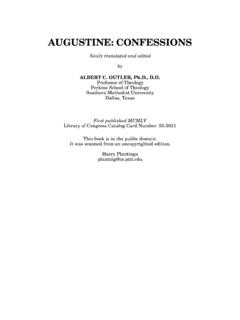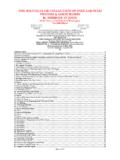Transcription of Medieval Food - Stanford University
1 Medieval Food Sunday, October 12, 14. Agriculture More intense agriculture Shift from animal products (meat and dairy). to various grains and vegetables Sunday, October 12, 14. Cereals were the staple Barley, oat and rye for poor Wheat for the governing classes Sunday, October 12, 14. Bread Finely milled flour was expensive, while the bread of commoners was typically brown and coarse Consumption around 1 to kilograms ( to lb) of bread per person per day. Among the first town guilds to be organized were the bakers', and laws and regulations were passed to keep bread prices stable. Nobility had their own baking staff, but there were public bakeries, normally owned by the local land lord, where the poorer people brought their bread to be baked communally, and later where they could buy ready-baked bread.
2 Sunday, October 12, 14. Bread and Food Regulations Food regulations and the Assize of Bread and Ale. 51 Hen. III, occurring about 1266 1267. regulated the price, weight and quality of the bread and beer manufactured laid out harsh punishments for brewers and bakers who were caught cheating. Worshipful Company of Bakers Bakers' Guild had the very onerous responsibility of enforcing the Bread Assize' within a radius of 2 miles from the City of London The disreputable cook from Geoffrey Chaucer's Canterbury Tales. Sunday, October 12, 14. Food (Bread) Machines For people in late Medieval Europe, the mill, whether wind or water, was the best-known example of a machine that converted inanimate power to work.
3 England had about ten thousand mills in 1300 and that they ground 80 percent of the grain was millled in them Four banal ( common oven ) was a feudal institution in Medieval France Personal ovens were generally outlawed and commoners were thus compelled to use the seigniorial oven to bake their bread. Sunday, October 12, 14. Sugar The spread of cultivation and manufacture of cane sugar to the Medieval Islamic world together with some upscaling of production methods. Crusaders brought sugar home with them to Europe after their campaigns in the Holy Land, where they encountered caravans carrying "sweet salt".
4 Early in the 12th century, Venice acquired some villages near Tyre and set up estates to produce sugar for export to Europe, From its first appearance in Europe, was viewed as much as a drug as a sweetener;. original of candy as medicine Sunday, October 12, 14. Spices Over 288 spices in Medieval Europe Most common were ginger, cinnamon, pepper, nutmeg, and saffron Common myth about Medieval food is that the heavy use of spices was a technique for disguising the taste of rotten meat Common seasonings in the highly-spiced sweet-sour repertory typical of upper-class Medieval food included verjuice, wine and vinegar, together with sugar and spices.
5 Common herbs such as sage, mustard, and parsley were grown and used in cooking all over Europe, as were caraway, mint, dill and fennel. Sunday, October 12, 14. Spices Spices were, instead, as sign of luxury and affluence. Connection to trading routes Around 1,000 tons of pepper and 1,000 tons of the other common spices were imported into Western Europe each year during the late Middle Ages. Value of these goods was the equivalent of a yearly supply of grain for million people. Sunday, October 12, 14. "Note that to every sauce and condiment salt is Sauces added, and crumb of bread to thicken it.
6 " - The vast majority of Medieval sauces are made with an acid vinegar, verjuice, or wine, as the base and bread crumbs as the thickener. Almonds were very popular as a thickener in soups, stews, and sauces, particularly as almond milk. Sunday, October 12, 14. Byrdys A wide range of birds were eaten, including swans, peafowl, quail, partridge, storks, cranes, larks, linnets and other songbirds Medieval pies (sometimes called "bake metis" in Medieval days) were often topped with either a pastry shell (often called a "coffin") or "byrdys.". Swans and storks apparently only eaten by the social elite, and more for their appearances than for their meat.
7 Sunday, October 12, 14. Food preservation 1. drying, 2. salting 3. smoking spices, fruit, and fish 4. pickling 5. sweet Preserves 6. fermentation Connection of food preservation to trade, especially in fish and fruit (and spice). 7. Confits Sunday, October 12, 14. Caloric Structure of Daily Life Diets were very high-carbohydrate, with most of the budget spent on, and the majority of calories provided by, cereals and alcohol Meat contributed a negligible portion of calories to a typical harvest worker's diet; however, its share increased after the Black Death and, by the 15th century, it provided about 20% of the total Even among the nobility of Medieval England, grain provided 65-70% of calories in the early 14th century Adult peasant male ate 2,900 calories (12,000 kJ) per day, and an adult female needed 2,150 calories (9,000 kJ).
8 Intakes of aristocrats may have reached 4,000 to 5,000 calories (17,000 to 21,000 kJ) per day. Monks consumed 6,000 calories (25,000 kJ) per day on "normal" days, and 4,500 calories (19,000 kJ). per day when fasting. Obesity was common among upper classes. Sunday, October 12, 14. Cookbooks The first cookbooks began to appear towards the end of the 13th century Le M nagier De Paris Forme of Cury Le Viandier de Taillevent Liber de Coquina Sunday, October 12, 14. Cookbooks Recipes were pretty sparse i - Tartes de chare. Take Freyssche Porke, and hew it, and grynd it on a mortere; and take it vppe in-to a fayre vesselle; and take the whyte an the3olkys of Eyroun, and strayne into a Vesselle thorw a straynoure, and tempere thin Porke ther-with; than take Pynez, Roysonys of Coraunce, and frye hem in freysshe grece, and caste ther-to pouder Pepir, and Gyngere, Canelle, Sugre, Safroun, and Salt, and caste ther-to, and do it on a cofynne, and plante thin cofynne a-boue with Pyne3, and kyt Datys, and gret Roysonys, and smal byrdys, or ellys hard 3olkys of Eyroun.
9 And 3if thou take byrdys, frye hem on a lytel grece or thow putte hem on thin cofynne, and endore with 3olkys of Eyroun, and Safroun, and lat bake til it be y-now, and serue forth. Smale Byrdys y-stwyde. Take smale byrdys, an pulle hem an drawe hem clene, an washe hem fayre, an schoppe of the leggys, and frye hem in a panne of freysshe grece ry3t wyl; than ley hem on a fayre lynen clothe, an lette the grece renne owt;. than take oynonys, an mynce hem smale, an frye hem on fayre freysshegrece, an caste hem on an erthen potte; than take a gode porcyon of canel, an wyne, an draw thorw a straynoure, an caste in-to the potte with the oynonys; than caste the bryddys ther- to, an clowys, an maces, an a lytil quantyte of powder pepir ther-to, an lete hem boyle to-gederys y-now; than caste ther-to whyte sugre, an powder gyngere, salt, safron, an serue it forth.
10 Sunday, October 12, 14. Cookbooks Guillaume Tirel aka Le Taillevent . One of the first truly "professional" master chefs. Taillevent helped start the modern favoring of Burgundy and strong (dry) red wine. Sunday, October 12, 14. Cookbooks Sunday, October 12, 14. Meals Two meals / day. No breakfast: Moralists frowned on breaking the overnight fast too early, and members of the church and cultivated gentry avoided it For practical reasons, breakfast was still eaten by working men Strong collectivist ethic of eating communally;. many large households, courts and religious orders forbade meals outside of the great hall at set times.














